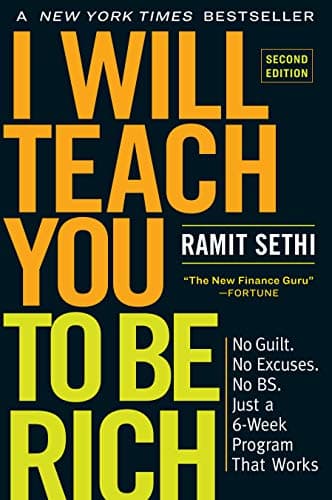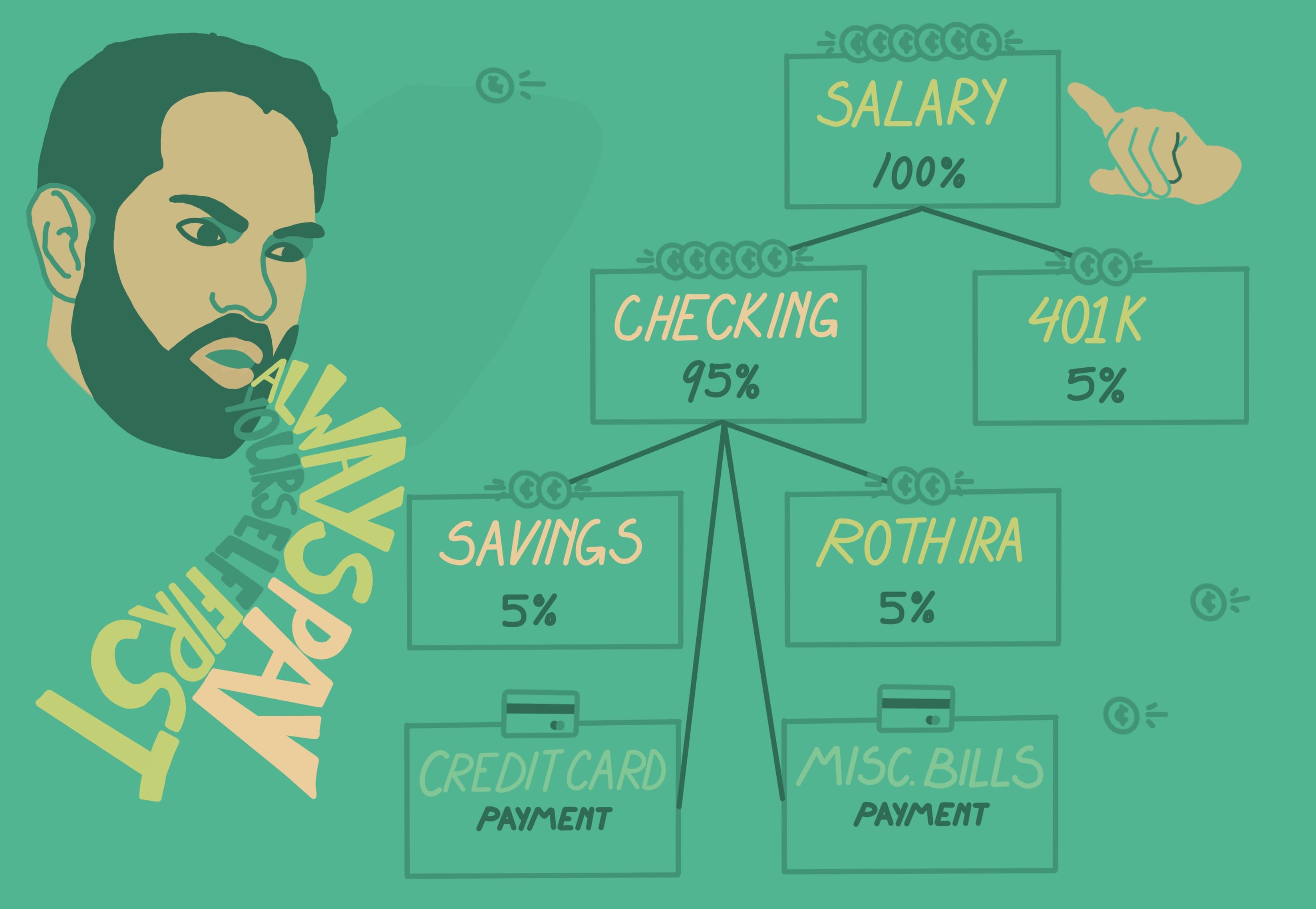I Will Teach You to Be Rich—Summary, Notes, + Quotes
The best introduction to personal finance and how to enjoy spending your money.

It’s unfortunate I Will Teach You To Be Rich has an off-putting title because it’s a fantastic introduction to personal finance.
Ramit Sethi’s goal is to make personal finance exciting and rewarding, a stark contrast from the dry, guilt-inducing material you typically would associate to the personal finance space.
He won’t blame you for spending lots of money on the things you enjoy; the same things most people would tell you is irresponsible to spend so much money on. Instead he encourages you to keep doing it unapologetically.
The catch? Cut spending harder in other areas.
“Spend extravagantly on the things you love, and cut costs mercilessly on the things you don’t.”
Ramit Sethi

His refreshing approach to money comes from the idea that money shouldn’t rule our lives, and instead be a tool to help us enjoy life.
Yes, he’ll encourage financial responsibility. Yes, he’ll advocate using a budget. Yes, he’ll try to persuade you to start saving for retirement immediately. But what makes Ramit different is he shows you how to get this important stuff done and out of the way by automating it.
This makes room to think about the fun stuff.
- Why do you want to be rich?
- What does being rich mean to you?
- What do you love to spend money on?
In This Summary of I Will Teach You to Be Rich
- how to make credit cards work for you
- how to set up the right bank accounts
- how to set up the right retirement accounts
- how to manage spending and enjoy it
- how to automate it all to be hands off
- how to invest intelligently with little work
I’m going to briefly cover his main recommendations from each topic, but because of his innovative approach to spending and budgeting and how practical it is, I’m going to spend a bit more time covering them.
“Everybody teaches you how to save. Nobody talks about how to spend.”
Ramit Sethi
How to Make Credit Cards Work for You
This section covers a lot about what a credit score is, how it’s calculated, and how credit cards work - all great for beginners. These are the notes I took for myself:
- always use a credit card over a debit card - builds credit, protects your bank account, accrue rewards
- always pay off credit cards in full each month - treat it like a debit card
- set up automatic payments so you never miss a payment
- keep old credit cards active by charging a small monthly cost to keep credit history
- switch credit cards to a no annual fee card when it’s no longer your primary card
- request credit limit increases to improve your credit utilization rate (a factor of your credit score)
- be aware of and use your rewards
- you can negotiate lower APRs and get late fees waived if you call and ask
The section ends with strategies to pay off credit card debt. It can be summarized by paying off debt with the highest intrest rate, but it’s more nuanced than that. If you do have credit card debt, this section is worth reading in full.
How to Set Up The Right Bank Accounts
I’m always surprised when I learn friends use traditional big banks for their accounts.
They typically have the worse benefits, have minimum balance requirements for checking accounts, and a poor online banking experience. Ramit does a good job exposing these pitfalls by explaining how banks make money and the tactics they use to lure you in and make it hard to leave.
Only a couple, but important takeaways on banks:
- switch to an online bank (I recommend Capital One)
- open a high-yield savings accounts (Capital One has them for free)
How to Set Up The Right Retirement Accounts
In the most important section so far, Ramit makes it simple to understand all the different types of retirement accounts and persuasively lays out why it’s so important to start saving for retirement now.
He created five systematic steps for investing he calls “The Ladder of Personal Finance.” When you finish the first step, or if it’s not an option, you proceed to the next step.
- contribute 100% of what your employer matches in a company 401k
- pay off credit card or other debt
- open a Roth IRA and contribute up to the annual maximum
- max out your 401k beyond or regardless of a company match
- put the rest in a non retirement brokerage account
The rest of this section goes deep into each step of the ladder, explaining everything very clearly. I was finally able to understand the tax advantages of each different kind of retirement account and also why it was valuable to start now.
How to Manage Spending and Enjoy It
Before you can learn to how to better manage your money he says you need to understand where you’re spending it.
To do this, he doesn’t recommend creating a budget where you track your finances down to the penny, but instead do what he calls a “Conscious Spending Plan,” which still sounds an awful lot like a budget, just a little more flexible.
Conscious Spending is Ramit’s method of allowing yourself to spend money on the things that bring you joy, even if they seem frivolous to other people, or even frivolous to you. In exchange, you cut the spending elsewhere. This is how Ramit defines frugality.
“Frugality isn’t about cutting your spending on everything. That approach wouldn’t last two days. Frugality, quite simply, is about choosing the things you love enough to spend extravagantly on - and then cutting costs mercilessly on the things you don’t love.”
Ramit Sethi
How to make a conscious spending plan
Divide up where your take home pay goes into four major buckets:
| Money Buckets | Percent of take home pay to allocate |
|---|---|
| I. Fixed Costs - Rent, utilities, debt, etc. | 50-60% |
| II. Investments - 401(k), Rotha IRA | 10% |
| III. Savings - Vacations, gifts, house down payment, unexpected expenses | 5-10% |
| IV. Guilt-free spending money - Dining out, drinking, movies, clothes, shoes | 20-35% |
- Fixed costs are expenses you have to pay every month no matter what. Once you total them up, subtract that amount from your take-home pay.
- Figure out how much you want to save for retirement in a 401k and or IRA and then deduct that amount.
- Think about what you want to save for in the short and long term. Calculate how much you need to save per month to reach that goal and then deduct that amount.
- After allocating money for fixed costs, retirement and investments, and savings, the rest is for guilt-free spending.
I made a budget template on Google Sheets based on Ramit’s Conscious Spending Plan that can you help do all this.
Tips to optimize your Conscious Spending Plan:
- always try to cut fixed costs and guilt-free spending before cutting how much you allocate to investing
- focus on big wins to cut spending, not small ones like buying generic brands
- you’re more likely to stick to a new budget by making a gradual change than a dramatic one
- actually write out tangible savings goals to increase motivation to achieve them
Use the “envelope system” to target big wins
The envelope system is essentially a second bucket system for your guilt-free spending. You allocate a certain amount of your guilt-free spending to certain categories (envelopes) and once you spend all the money in that envelope, that’s it.
It’s much easier to figure out how much money you should put into each envelope by looking at your last three months of spending in each category, averaging them out, and then setting an achievable goal for each one.
It’s a good objective to try and meet your spending goal for each category, but you can dip into other envelopes if you need to. The most important thing is keeping your total spending below what you have for guilt-free spending.
Activity based envelopes
One trick Ramit mentions that I’ve used in the past is instead of using the general categories that credit card companies and banks typically use, create categories more personal to you and around events.
For example, I have used these categories in the past:
- eating out alone
- coffee
- alcohol for home
- going out with friends
While this requires a manual categorization of each expense, it will highglight the driving activities behind your spending.
The best way to keep track of spending is to always use a credit card (as long as your responsible) so you can just pull up your account to enter expenses into your budget.
“The best part about setting up a strategic budget is that it guides your decisions, letting you say no much more easily - ‘Sorry, it’s not in my plan this month.’ - and freeing you up to enjoy what you do spend on. This is guilt-free spending at its best.”
Ramit Sethi
How to Automate It All to be Hands Off
If you’re contributing to a 401k, that’s probably already automated by your employer before even receiving your paycheck.
Then your paycheck gets deposited into your checking account and from there you set up a monthly automatic transfer to your other retirement and savings accounts. By transferring the money automatically right after you get paid, you’re paying yourself first, not spending first and saving what’s left over. That’s why the money left over to spend is guilt-free spending money.
Here’s what the flow looks like:

“By setting up an automatic payment plan you actually make it difficult to stop the contributions to your retirement account! Not because you can’t - you can adjust your system any time - but because you’re lazy and you won’t.”
Ramit Sethi
More automation tips:
- set up all bills to be paid by credit card automatically
- if a bill (like rent) can’t be paid by card, set up auto bill pay to have your bank automtically send a check on your behalf
- set up your credit card bill to be paid automatically from your checking account
- set a reminder in the middle of the month to check how you much you’ve spent compared to what you’ve allocated for guilt-free spending
How to Invest Intelligently with Little Work
In this section of I Will Teach You to be Rich, Ramit walks us through how to invest the money in your 401ks and IRAs. It’s a good introduction to the foundational topics of investing that can be summed up in a few points:
- be less risk averse when you’re younger, more risk averse when older
- hardly anyone beats the market, even full-time investors so it’s not worth trying to pick the right stocks
- don’t invest in any funds with high fees, like mutual funds
- it’s better long term to invest in low-fee index funds
- some diversification is good, just remember to rebalance your ratios annually
- invest in lifecycle funds to be completely hands off
Ramit goes into more details on each one of these here and explains why he gives the advice he does. It’s solid financial advice and worth reading more into if you’re fresh to personal finance.
Final Personal Finance Tips
- try and invest as much as you can, as early as you can
- if your income increases, look to increase how much you allocate to savings first
- ignore the noise of the financial industry, it can cause you to get emotional and make bad decisions
- don’t worry about tricks to avoid taxes or seeing a financial advisor until your investments total $100k+
- create an emergency fund to protect against job loss or unexpected, expensive bills
“Unlike other people, who worry about money (because they never learned how it works), you get to focus on the things you love.”
Ramit Sethi
You might also enjoy
-

Untethered Soul by Michael Singer—Summary, Notes, + Quotes
A spiritual exploration into who we are and who we ought to be.
-

War on Normal People—Summary, Notes, + Quotes
Is universal basic income the answer?
-

The Effective Executive—Summary, Notes, + Quotes
The essential handbook to learn leadership and effectiveness at work.
-

Mastery by Robert Greene—Summary, Notes, + Quotes
The essential book to help you find your purpose.
Never Miss an Article
Get notified by email when I publish a new article.
